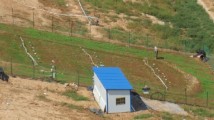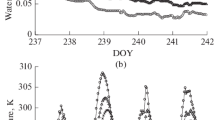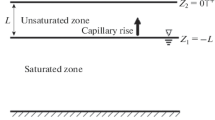Abstract
It is important to obtain the amount of evaporation from the slope surface to analyze slope stability after rainfall. The bulk method is one of the evaporation estimation methods. Using this method, the amount of evaporated water from bare ground surfaces can be estimated from the general meteorological data. The evaporation efficiency, β, is an important parameter of the bulk method and is influenced by the volumetric water content in unsaturated soil. The molecular diffusion distance, F(Wv), is also an important parameter to calculate β. F(Wv) is influenced by the type of surface soil, the void ratio, and the volumetric water content, etc. The functional form of F(Wv) was obtained from experiments, and the experimental relationships between the volumetric water content and F(Wv) for loam and sand were explained by Kondo et al. In this paper, a numerical model for the molecular diffusion distance, F(Wv), derived from soil parameters such as grain size and void ratio is proposed, and β obtained from our proposed numerical model is compared with the results of laboratory tests by Sako et al. As a result, the applicable scope of the numerical model and the necessity of improvement of the numerical model are discussed.
Access provided by Autonomous University of Puebla. Download conference paper PDF
Similar content being viewed by others
Keywords
1 Introduction
Countermeasures for rainfall-induced slope failure are classified roughly into structural measures and non-structural measures. It takes a lot of time and money to implement structural measures at all dangerous points, so it is desirable to enhance non-structural measures. In non-structural measures, evacuation advisories and traffic regulations are conducted. However, conventional evacuation advisories and traffic regulations focus on setting standards for issuance based on rainfall intensity, and there are no clear standards for cancelation of issuance. To set standards for cancelation of issuance, it is necessary to assess the slope stability after rainfall. It is important to obtain the amount of evaporation to analyze the slope stability after rainfall.
The bulk method is one of the evaporation estimation methods. In this method, if the exchange speed, ga, and the evaporation efficiency, β, are known in advance, the amount of evaporated water from bare ground surfaces can be estimated from the general meteorological data. The molecular diffusion distance, F(Wv), is an important parameter to calculate β. F(Wv) is influenced by the type of surface soil, the void ratio, and the volumetric water content, Wv, etc. [1].
In this paper, a numerical model for the molecular diffusion distance, F(Wv), derived from soil parameters such as grain size and void ratio is proposed, and the validity of the numerical model is discussed. The numerical model is based on the numerical model for the seepage behavior of unsaturated soil proposed by Sako et al. [2]. Firstly, the outline of the bulk method and the numerical model proposed by Sako et al. [2] is described. Especially, the relationship between the volumetric water content and the molecular diffusion distance (Wv–F(Wv) relation) is explained. Secondly, the outline of our proposed numerical model is described, and the evaporation efficiency, β, is calculated using the numerical model. Comparing with the results of laboratory experiments by Sako et al. [3], the applicable scope of the numerical model and the necessity of improvement of the numerical model are discussed.
2 Outline of the Bulk Method
The estimation method of evaporation using the bulk method (β-method) is expressed as the following equation:
where E is the evaporation per unit area [kg m−2 s−1], ρ is the air density [kg m−3], ga is the exchange speed [m s−1], β is the evaporation efficiency [−], qSAT(Ts) is the saturation specific humidity at the soil surface temperature, Ts [kg kg−1], and qa is the specific humidity of the air [kg kg−1]. Almost all parameters of the bulk method can be derived from the general meteorological data. However, the exchange speed, ga, and the evaporation efficiency, β, have to be derived from the laboratory experiments. β is surface moisture availability and has a value in the range between 0 and 1 depending on the soil moisture (e.g., β = 0 at dry condition, β = 1 at saturated condition). Kondo et al. [4] have proposed the equation of the relationship between the volumetric water content and the evaporation efficiency (Wv–β relation) obtained from the experiments. Using F(Wv) which is a function of the volumetric water content, Wv, β is expressed as the following equation:
where F(Wv) is the molecular diffusion distance [m], and Datm is the molecular diffusion coefficient for water vapor [m2 s−1]. The molecular diffusion distance, F(Wv), is a parameter with a length dimension and expresses the distance of the flow of water vapor from the water surface in the soil pore to the land surface. The functional form of F(Wv) is obtained from experiments and varies depending on the type of soil. Kondo et al. [1] have proposed the equation relating the volumetric water content to the molecular diffusion distance (Wv–F(Wv) relation) obtained from the experiments. The equation of the Wv–F(Wv) relation is expressed as the following equation:
where Wv, SAT is the saturated volumetric water content [m3 m−3]. Table 1 shows the F(Wv) constants, F1 and F2 for typical types of soil. When Wv is large, F(Wv) is quite small. This is because water exists in large pores near the ground surface, and water vapor is easily transported to the ground surface. When Wv is small, F(Wv) increases with a decrease in Wv. This is because water exists only in small complicated pores, and the distance for the water vapor to reach the ground surface from the pore is relatively large.
In this paper, the numerical model for the molecular diffusion distance, F(Wv), derived from soil parameters such as grain size and void ratio is proposed.
3 Outline of the Numerical Model for the Seepage Behavior of Unsaturated Soil
Unsaturated soil is composed of three phases (viz. the solid phase (soil particles), the liquid phase (pore water) and the gas phase (pore-air)). Figure 1a shows a soil element with a few soil particles. This element can be modeled as shown in Fig. 1b. The voids are represented as a pipe with a diameter (Dv) and an inclination angle (θ). The soil particles are represented as other impermeable parts of the model minus the space occupied by the pipe. The element shown in Fig. 1a is called elementary particulates, and the model shown in Fig. 1b is called an elementary particulate model. The volume of the elementary particulate model, Ve, and that of the pipe, Vp, are expressed as follows.
where Dv is the diameter of the pipe, θ is the inclination angle of the pipe, and Dcha is the height of the elementary particulate model. In this paper, the height of the elementary particulate model, Dcha, is set to 10% passing particle size, Ds, 10 (viz. Dcha = Ds, 10). It was found from previous research work (Akai [5]) that Ds, 10 is one of the factors that influence the permeability coefficient.
The shape of voids in soil is complex because the shape and size of soil particles are random, and the structure of their assembly is irregular. Therefore, the diameter of the pipe, Dv, and the inclination angle of the pipe, θ, are regarded as random variables. Consequently, in this model, the probability density functions for Dv and θ are introduced. This model assumes that water enters in order from small pores and exits in order from large pores. Furthermore, the maximum diameter of pipes filled with water is defined as d. From the above, the void ratio, e, the degree of saturation, Sr, and the volumetric water content, Wv, are expressed through the following equations:
where Pd(Dv) is the probability density function for the diameter of the pipe, Pc(θ) is the probability density function for the inclination angle of the pipe, and d is the maximum diameter of pipes filled with water.
4 Numerical Model for the Molecular Diffusion Distance, F(Wv)
4.1 Outline of the Numerical Model for the Molecular Diffusion Distance, F(Wv)
The molecular diffusion distance, F(Wv), is a parameter with a length dimension. The numerical model for the molecular diffusion distance, F(Wv), is proposed using the model pipe shown in Fig. 2. The volume of pore water in the surface soil per unit volume, Vw, is modeled by the pipe with diameter Dp. In this model, the depth of the surface soil is assumed as 2 cm deep from the ground surface based on the experiment [3]. The maximum length of the model pipe is defined as LSAT, and the length of the model pipe, L, is determined depending on the volumetric water content, Wv, in the surface soil. The difference between LSAT and L is F(Wv). F(Wv) means the transport length of water vapor from the water surface in the soil pore to the land surface. F(Wv) is expressed as follows:
where e is the void ratio, Sr is the degree of saturation, and Dp is the diameter of the model pipe. The scheme of the model pipe to calculate the relationship between the volumetric water content and the molecular diffusion distance (Wv–F(Wv) relation) is also shown in Fig. 2. To calculate the Wv–F(Wv) relation by this scheme, it is necessary to determine the diameter of the model pipe, Dp. Dp is examined in the next section.
4.2 Examination of the Diameter of the Model Pipe
Table 2 shows the equations used to examine the diameter of the model pipe, Dp. In Case 1, the maximum diameter of pipes filled with water, d, is used as Dp, because it seems that d is the diameter of the pipe that mostly affects the molecular diffusion distance, F(Wv). In Case 2, the mean value of the diameter of pipes filled with water is used as Dp. The probability density functions for the diameter of the pipe, Pd(Dv), are corrected using the cumulative distribution functions for the diameter of the pipe, and Dp is calculated. In Case 3, the integration with respect to the product of the diameter of pipes filled with water and its probability is used as Dp. Unlike Case 2, Pd(Dv) is not corrected using the cumulative distribution functions for the diameter of the pipe.
Using the equations shown in Table 2, the relationship between the volumetric water content and the molecular diffusion distance (Wv–F(Wv) relation) was calculated. The diameter of the model pipe, Dp, was examined by comparing the calculation results with the experimental results by Sako et al. [3]. Figure 3 shows Wv–F(Wv) relation obtained from a calculation using the equations shown in Table 2. The experimental results by Sako et al. [3] are also shown in Fig. 3. Toyoura sand (void ratio, e = 0.785) was used as the soil sample. In all cases, the calculation results are larger than the experimental results. It seems that the overestimation of the calculation results is caused by the calculation method of the volume of pore water in the surface soil. Therefore, it is necessary to improve the volume of pore water to be modeled. The improved model is proposed in the next section.
4.3 Improvement of the Numerical Model for the Molecular Diffusion Distance, F(Wv)
In this section, the improved model for the molecular diffusion distance, F(Wv), is proposed. It seems that the molecular diffusion distance, F(Wv), shown in Eq. (9) is calculated as the sum of multiple pores. It is the reason why the calculation results shown in Fig. 3 were overestimated. In the improved model, F(Wv) is calculated as the mean value in pores filled with water. The volume ratio of the surface soil per unit volume and the elementary particulate model is used to improve the volume of pore water. In the improved model, the volume of pore water in the surface soil used in Eq. (9) is corrected using the volume of the elementary particulate model, Ve. Then, F(Wv) is expressed as the following equation.
where d is the maximum diameter of pipes filled with water, Ve is the volume of the elementary particulate model, Pd(Dv) is the probability density function for the diameter of the pipe, Pc(θ) is the probability density function for the inclination angle of the pipe, Dv is the diameter of the pipe, and θ is the inclination angle of the pipe. Figure 4 shows the relationship between the volumetric water content and the molecular diffusion distance (Wv–F(Wv) relation) obtained from a calculation using the equations shown in Table 2. The experimental results by Sako et al. [3] are also shown in Fig. 4. It is found from Fig. 4 that the tendency of the calculation results for Case 3 is the closest to the experimental results. Therefore, it seems that the equation for Case 3 is the most appropriate as the diameter of the model pipe, Dp. However, it is necessary to examine the validity of using the equation for Case 3.
5 Relationship Between the Volumetric Water Content and the Evaporation Efficiency
Figure 5 shows the relationship between the volumetric water content and the evaporation efficiency (Wv–β relation) obtained from the calculation using our proposed numerical model. From the results shown in Fig. 4, the equation for Case 3 was used as the diameter of the model pipe, Dp. The experimental results by Sako et al. [3] are also shown in Fig. 5. In the range of ① in Fig. 5, the tendency of the calculation results is almost the same as the experimental results. However, in the range of ② in Fig. 5, the tendency of the calculation results is different from the experimental results, because the calculation results of the molecular diffusion distance, F(Wv), and the experimental results are different in terms of the volumetric water content, Wv, corresponding to the range of ② in Fig. 5. Therefore, it is necessary to improve the numerical model further.
6 Conclusions
The numerical model for the relationship between evaporation efficiency and volumetric water content was discussed in this paper. Firstly, a numerical model for the molecular diffusion distance, F(Wv), derived from soil parameters such as grain size and void ratio was proposed as shown in Eq. (9). Three equations on the diameter of the model pipe, Dp, were also proposed. Comparing with the experimental data and the calculation data, the applicability of these equations for Eq. (9) was discussed. As a result, all calculation results were overestimated. Then, the improved equations on the molecular diffusion distance, F(Wv), were proposed again, and the improved F(Wv) using three equations on Dp was calculated. The equation for Case 3 resulted in a better result than the others. However, it is necessary to examine the validity of using the equation for Case 3. Finally, the relationship between the volumetric water content and the evaporation efficiency (Wv–β relation) was calculated using F(Wv) derived from Eq. (10) and the Dp expressed by Case 3. In the range of low volumetric water content, the tendency of the calculation results showed good agreement with the experimental data. However, in the range of high volumetric water content, the tendency of the calculation results underestimated the experimental results. It is necessary to improve the numerical model further to be in good agreement with the experimental data.
References
Kondo, J., Saigusa, N., Sato, T.: A parameterization of evaporation from bare soil surfaces. J. Appl. Meteor. 29, 385–389 (1990)
Sako, K., Kitamura, R.: A practical numerical model for seepage behavior of unsaturated soil. Soils Found. 46(5), 595–604 (2006)
Sako, K., Moriiwa, M., Satomi, T.: Experimental consideration on evaporation efficiency β of unsaturated sandy soil surface. In: Proceedings of the 15th Asian Regional Conference on Soil Mechanics and Geotechnical Engineering, No.JPN-29 (2015).
Kondo, J.: Mizukankyo no kishogaku (Meteorology of water environment), Asakurashoten 197–198 (1994) (in Japanese)
Akai, K.: Events on Seepage, Soil Mechanics. In: Mogami, T. (Ed.) Gihodo, pp. 99–102 (1969) (in Japanese)
Author information
Authors and Affiliations
Corresponding author
Editor information
Editors and Affiliations
Rights and permissions
Copyright information
© 2021 The Author(s), under exclusive license to Springer Nature Singapore Pte Ltd.
About this paper
Cite this paper
Jikuya, Y., Sako, K., Ito, S. (2021). A Consideration on Numerical Model for the Relationship Between Evaporation Efficiency and Volumetric Water Content. In: Hazarika, H., Madabhushi, G.S.P., Yasuhara, K., Bergado, D.T. (eds) Advances in Sustainable Construction and Resource Management. Lecture Notes in Civil Engineering, vol 144. Springer, Singapore. https://doi.org/10.1007/978-981-16-0077-7_21
Download citation
DOI: https://doi.org/10.1007/978-981-16-0077-7_21
Published:
Publisher Name: Springer, Singapore
Print ISBN: 978-981-16-0076-0
Online ISBN: 978-981-16-0077-7
eBook Packages: EngineeringEngineering (R0)









